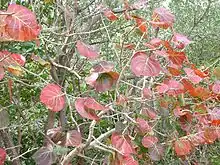| Coccoloba | |
|---|---|
 | |
| Coccoloba uvifera (Seagrape) bush | |
| Scientific classification | |
| Kingdom: | Plantae |
| Clade: | Tracheophytes |
| Clade: | Angiosperms |
| Clade: | Eudicots |
| Order: | Caryophyllales |
| Family: | Polygonaceae |
| Subfamily: | Eriogonoideae |
| Genus: | Coccoloba P.Browne |
| Species | |
|
See text | |
Coccoloba is a genus of about 120–150 species of flowering plants in the family Polygonaceae,[1] which is native to the Neotropics. There is no overall English name for the genus, although many of the individual species have widely used common names.
Range
The genus is native to tropical and subtropical regions of the Americas, in South America, the Caribbean and Central America, with two species extending into Florida.[2][3]
Description
_How._-_Flickr_-_Alex_Popovkin%252C_Bahia%252C_Brazil_(10).jpg.webp)
The species are shrubs and trees, and lianas, mostly evergreen. The leaves are alternate, often large (to very large in some species; up to 2.5m (8 feet) long in C. gigantifolia),[4] with the leaves on juvenile plants often larger and of different shape to those of mature plants. The flowers are produced in spikes. The fruit is a three-angled achene, surrounded by an often brightly coloured fleshy perianth, edible in some species, though often astringent.[2][3] Species in the genus have been characterized as dioecious,[5] but this is unclear.[6] Trioecy has been documented in C. cereifera.[7]
Selected species
- Coccoloba acuminata
- Coccoloba barbadensis – Uvero
- Coccoloba caracasana – Papaturro
- Coccoloba cereifera
- Coccoloba costata – Uvilla
- Coccoloba diversifolia – Pigeonplum
- Coccoloba gigantifolia (with human-sized leaves[8])
- Coccoloba goldmanii
- Coccoloba krugii – Whitewood seagrape
- Coccoloba microstachya – Puckhout
- Coccoloba mollis
- Coccoloba padiformis
- Coccoloba pallida – Pale seagrape
- Coccoloba pauciflora – Uvilla cimarrona[9]
- Coccoloba pubescens – Grandleaf seagrape
- Coccoloba pyrifolia – Uvera
- Coccoloba rugosa – Ortegon
- Coccoloba sintenisii – Uvero de monte
- Coccoloba swartzii – Swartz's pigeonplum
- Coccoloba tenuifolia – Bahama pigeonplum
- Coccoloba tuerckheimii
- Coccoloba uvifera – Seagrape
- Coccoloba venosa – False chiggergrape
Ecology
The species Coccoloba cereifera is notable for being restricted to an area of only some 26 square km on a single low peak near Serra do Cipó National Park, in the Brazilian state of Minas Gerais.[14]
Cultivation and uses
One species, Coccoloba uvifera (Seagrape) is commonly cultivated for its edible fruit, and the genus name is sometimes used to denote this species.
References
- ↑ Acevedo-Rodriguez, Pedro; Strong, Mark (2012). "Catalog of Seed Plants of the West Indies" (PDF). Smithsonian Contributions to Botany. 98: 1–1221. doi:10.5479/si.0081024X.98.1.
- 1 2 Flora of North America: Coccoloba
- 1 2 Huxley, A., ed. (1992). New RHS Dictionary of Gardening. Macmillan ISBN 0-333-47494-5.
- ↑ J.G. Rohwer, Tropical Plants of the World (New York: Sterling, 2002)
- ↑ Howard, Richard A. (1949). "The Genus Coccoloba in Cuba". Journal of the Arnold Arboretum. 30 (4): 388–424. doi:10.5962/bhl.part.18052. JSTOR 43782355.
- ↑ Madriz, Rosario; Ramirez, Nelson (1996–1997). "Biologia reproductiva de Coccoloba uvifera (Polygonaceae) una especie poligamo-dioica". Revista de Biología Tropical. 44(3)/45(1): 105–115.
- ↑ Silva, Clice Alexandre; Oliva, Marco Antonio; Vieria, Milene Faria; Fernandes, Geraldo Wison (2008). "Trioecy in Coccoloba cereifera Schwacke (Polygonaceae), a Narrow Endemic and Threatened Tropical Species". Brazilian Archives of Biology and Technology. 51 (5): 1003–1010. doi:10.1590/S1516-89132008000500017.
- ↑ "Amazonian Tree With Human-Sized Leaves Finally Gets New Species Recognition". EcoWatch. 2019-11-28. Retrieved 2019-12-11.
- ↑ Timyan, J. (2022). "Coccoloba pauciflora". IUCN Red List of Threatened Species. 2022: e.T188895851A188913988. doi:10.2305/IUCN.UK.2022-2.RLTS.T188895851A188913988.en. Retrieved 15 December 2022.
- ↑ USDA Plants Profile: Coccoloba
- ↑ Global Compendium of Weeds: Coccoloba acuminata
- ↑ Plants of Hawaii: Polygonaceae Archived 2008-05-04 at the Wayback Machine
- ↑ Melo, E.; Cid Ferreira, C.A.; Gribel, R. (11 November 2019). "[Botany • 2019] Coccoloba gigantifolia (Polygonaceae) • A New Species of Coccoloba P. Browne from the Brazilian Amazon with Exceptionally Large Leaves". Species New to Science. novataxa.blogspot.com. Retrieved 24 November 2019.
- ↑ Katia Torres Ribeiro; G. Wilson Fernandes (1999). "Geographic distribution of Coccoloba cereifera Schw. (Polygonaceae), a narrow endemic plant from Serra do Cipó, Brazil" (PDF). Archived from the original (PDF) on 2011-07-06.
{{cite journal}}: Cite journal requires|journal=(help)
External links